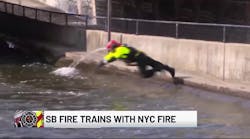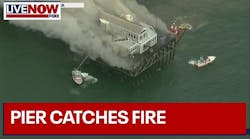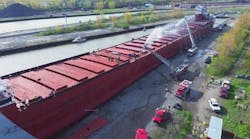The old saying, "putting the wet stuff on the red stuff" has built into it the huge assumption that the "wet stuff" will exit the nozzle with enough pressure to protect firefighters while extinguishing the fire as quickly as possible. There are two essential elements to an aggressive interior attack: air and water. If either is inconsistent, unreliable or not present, the results of the attack are likely to be disastrous. The fire service adheres to strict guidelines regarding the purchasing and servicing of self-contained breathing apparatus (SCBA), which satisfies the need for air in this equation. Yet, honestly, can the same be said about the servicing of the hose that provides the second essential element? Unfortunately, in most cases, the answer is no.
Throughout the United States, there exists confusion and uncertainty about the annual testing of equipment; specifically, for the purpose of this article, fire hose testing. The National Fire Protection Association (NFPA) 1962 standard, a nationally reorganized standard, requires all fire hose to be tested annually. There are certain criteria for testing occupant-use hose: five years after date of manufacture and every three years thereafter (as indicated in section 4.3.2 of NFPA 1962, 2008 edition). However, it is imperative that each district check with the Authority Having Jurisdiction (AHJ) for detailed specifications for hose testing within occupancies such as factories, hospitals, shopping centers, industrial sites and schools. The chance of encountering faulty or unreliable hose in these places is very likely, and high-rise packs are available to firefighters for protection in these instances, but again, have these been tested?
Though most fire departments strive to achieve the standards set forth by the NFPA, there are still stations and/or departments where hose testing remains a low-priority or sparsely completed chore. Why might this mandatory and highly important safety measure go overlooked so often? The following list is comprised of speculation and is, by no means, all inclusive:
- "You don't know what you don't know…" — Some departments are unaware of NFPA 1962. This lengthy document meticulously outlines the specifications for the "Inspection, Care and Use of Fire Hose, Couplings, and Nozzles and the Service Testing of Fire Hose." Now you are aware and should research this standard.
- "We meet their standards…" — State insurance departments may have less-stringent guidelines or laws regarding hose testing. However, in a court of law, compliance with NFPA will be viewed as compliance with a National Recognized Standard, which potentially could override state law and other regulations. Legally, the existence of a national standard indicates that all hose-testing processes should be equal to or exceed these standards. Some states have accepted and/or adopted NFPA standards and non-compliance with these standards is against state and national regulations.
- "We follow OSHA regulations…" — There are no specifications within the Occupational Safety and Health Administration (OSHA) regulations directly pertaining to yearly hose testing. However, as indicated in CFR 29 1910.156(d): Firefighting equipment shall be "maintained and inspected" at least annually, extinguishers and respirators monthly. How does one maintain and/or inspect hose without service testing for leaks? In neglecting to properly test and maintain fire hose, employers are essentially neglecting to meet regulations set forth by OSHA to protect the health and safety of their employees.
- "It's new hose, we don't need to test it…" — Many departments don't realize that "new" hose often is not tested. Most manufacturers test fire hose before shipping it only if the customer has requested this be done prior to purchasing it; therefore, new hose still needs to be tested before being placed into service. A department should check with the manufacturer prior to purchasing hose to guarantee that it has been tested as a fully constructed hose, with the coupling on, before being shipped.
"We can't because…" — Departments run across many problems when attempting to arrange annual fire testing. The labor-intensive nature of hose testing makes it an undesirable chore and it is often difficult to acquire the necessary manpower within a volunteer department. Those volunteers who do make themselves available to test hose often face hours of labor using equipment that is not designed to test the large quantities of hose they often face. Traditional hose-testing equipment can test only small portions of hose, while the use of engines to test hose may damage the apparatus or void corresponding warranties. This inappropriate testing equipment limits productivity and hinders morale.
Testing is also dangerous. There is an undeniable risk for injury and even death. Not only do fire departments want to avoid harm to their members and employees, it is also likely that the department wishes to avoid the costs of worker's compensation and coverage for shifts missed by injured persons. The U.S. Fire Administration (USFA) reports approximately 100 on-duty deaths per year, with 64% of those being career personnel performing in-station duties. Deaths such as that of the Georgia fire chief killed during routine hose testing in 2000 are rare, but national statistics and websites such as www.firefighternearmiss.com document the frequent "close calls" that could have easily ended in tragedy.
- "And because…" — There are various other reasons why departments may not test hose to NFPA standards, including the common mistake of not testing portions of hose that are believed to have been tested in recent years and/or are being used as "rack" or "reserve" hose. It is highly likely that departments that omit "rack" hose from testing will switch out hose from this "reserve" pile, thus putting untested hose in service. Also, the potential for intricate hose-testing records to be lost, damaged or poorly kept allows for many errors and omissions that prevent hose from being tested to standard.
It may seem discouraging to read a lengthy list of obstacles that may prevent a hard-working and reputable department from meeting standards, but there is an answer that more and more departments are turning to: in-house or third-party testing.
While there are many departments, career and volunteer, that do their own hose testing; there are also third-party hose testers with experience, knowledge and equipment that allows them to test tens of thousands of feet per day. Third-party testing can largely eliminate your liability and eradicate the need for excuses. As previously stated, the risk for injury and even death during testing is very real for an inexperienced crew or a department without proper equipment. Allowing a trained and knowledgeable crew to test hose guarantees a safe, efficient and cost-effective experience for the department.
Third-party testers use their own specially designed pumps that can handle up to 20,000 feet of hose in a test day. Naturally, this depends on the testing area being spacious enough to handle the 300-foot maximum length and wide enough to handle the multiple manifold pumps. Most third-party testers can test multiple-diameter hose at the same time. This, coupled with the amount of hose being tested at once, can test a complete apparatus at one time, saving departments from the hassle of taking trucks out of service for long periods. These experienced contractors have developed a skillful eye for hose failures and record keeping as it relates to the NFPA standard. They are totally familiar with the service test pressures on hose being manufactured before and after July 1987. Also, as indicated in section 7.6.1.4 of NFPA 1962, 2008 edition; the test gauges used to read the test pressure must be calibrated within the previous 12 months. When using a third-party tester, it is imperative to verify that its gauges have been calibrated within this period.
Third-party hose testers may offer other services: access to test records 24/7 or just hardcopy of reports, ground ladder testing and even ISO 9001 — Quality Management Certification. This certification indicates a strenuous control of processes, procedures and customer-satisfaction reports measured against strict yearly audits by an ISO auditor for compliance. ISO-9001 is new to the fire service, but has been used in the business/manufacturing community for a while. The ISO-9001 mark indicates a well-developed, well-defined, excusable and measurable process toward an end result. In this case, it would be measured against NFPA 1962. ISO-9001 is totally different and has no relationship with the well-known ISO insurance measurement/grading that exists in the fire service.
Finally, one factor not so widely recognized is that hose testing contributes to points during an ISO insurance rating review. The points are a subset of your overall ISO insurance review, but do contribute to the end results in establishing local insurance rates. And, if hiring a third-party tester, by no means should a department be expected to allow fire department members to participate in the testing procedure, as this could affect the department's liability.
When shopping around for third-party testers, also be mindful of the old saying "you get what you pay for." If bid prices differ by much, there is usually something that a company lacks or cannot offer. If the differences in price are small, be aware of what each complete testing package will offer and whether saving a small amount is worth sacrificing quality. For instance, are the companies looking to perform your hose testing owner operated or is a crew sent out by someone else? With an owner/operator, there is pride in the job and the ability to adapt to your last-minute needs. An owner/operator on scene allows the department a more personal experience.
The relatively minor cost associated with hose-testing programs pales in comparison with the almost incalculable value of preventing equipment failure in terms of both safety and reliability. Whether a department conducts its own testing or chooses an outside source, it is important to complete the testing as prescribed by NFPA 1962 or better. If a department wants to be recognized for doing all it can to keep personnel safe, it should give the same priority to servicing hose as is given to SCBA and fire pumps. Remember while examining all safety challenges: People don't plan to fail — they fail to plan.
JOHN WM. GREEN has over 30 years of experience as a firefighter and is a past chief of the Roosevelt Fire District in Hyde Park, NY. He also has served as a New York State fire instructor and OSHA instructor. Green retired after 30 years as a development educational program manager at IBM and served six years as a professional industrial firefighter at IBM after retirement. He is franchise manager for Waterway Inc.





